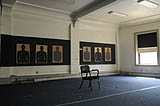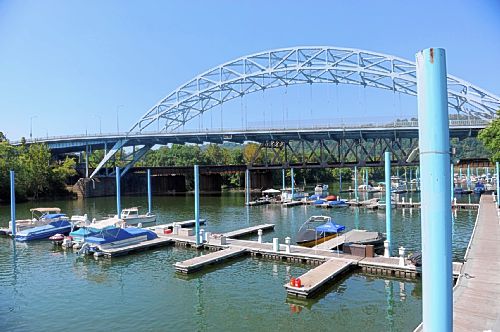
Author Archives: ryochum
-
Fire Engine House in North Point Breeze Up for Sale
Offers due Oct. 22; tour set ThursdayMonday, September 06, 2010By Joe Smydo, Pittsburgh Post-Gazette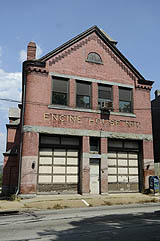
The Engine No. 16 firehouse in North Point Breeze is up for sale. Proposals for use of the space are due Oct. 22 and guidelines are posted for would-be purchasers. Rebecca Droke/Post-Gazette
The fire trucks and alarm bells may be long gone, but city officials believe Engine House No. 16 still has a dynamic role to play in the East End.
Officials said they’d like to sell the building and have posted guidelines for would-be purchasers. The request for proposals is on www.buyintheburgh.com, a year-old database of properties for sale by the city and Urban Redevelopment Authority.
The two-story, red-brick building is at Penn and North Lang avenues in North Point Breeze. Built in the early 1900s, it has 6,500 square feet of space and an appraised value of $90,000. Other features are two drive-in bays, 16-foot ceilings and a full basement.
The engine house’s name still adorns the front of the structure.
“It’s a gorgeous building,” said URA executive director Rob Stephany.
The city stopped using the building as a fire station in the late 1980s or early 1990s, but it’s still used to provide classroom training to firefighters. Overall, the URA said, it’s in fair condition.
Mr. Stephany said the building is well suited for an architect’s studio, condominiums or a home-business combination. Claire Hosteny, URA senior real-estate development specialist, said one drawback is a lack of parking space outside.
Proposals are due to the URA by noon Oct. 22. A walk-through is scheduled for 9 a.m. Thursday.
No public subsidies are available for renovation. The URA is helping to vet proposals, but the decision to sell rests with City Council and the mayor’s office.
In other cities, old firehouses have been converted into homes and businesses. In March, Chicago officials decided to seek redevelopment proposals for the old Engine Co. 18 firehouse, a two-bay structure built in 1873 on the city’s Near West Side. Officials said they’re interested in a commercial or mixed-use development.
Mr. Stephany said redevelopment of the North Point Breeze building can have a “catalytic impact” on a part of the city poised for progress. He said the development opportunity comes amid a master-planning process for the Homewood-North Point Breeze area.
In highlighting the firehouse development opportunity last week, officials also sought to focus renewed attention on the property website, which lists about 4,300 properties for sale. Properties may be searched by address and neighborhood. The website provides details on each property and has information on the city’s tax-abatement and green-up programs.
-
In McKeesport, Marina’s Success Boosts Other Businesses, City’s Hopes
Thursday, September 09, 2010By Candy Woodall, freelancePittsburgh Post-GazetteSummer may be winding down but Ray Dougherty already is preparing for next season at McKees Point Marina along the Youghiogheny River.
The 200 docks are full to capacity, and the waiting list is growing, a stark difference from the 60 spots that were filled when Mr. Dougherty started as manager of the marina in McKeesport four years ago.
In addition to the solar, steel building he plans to have constructed along Water Street to house boats during the off-season using a $150,000 Growing Greener grant, growth at the marina also has led to a new boat dealer opening in McKeesport and increased revenues at McKees Cafe.
He attributes the surge at the marina to reducing rates and adding entertainment.
The marina hosts free, live entertainment every weekend.
Rates were $1,080 annually for either a 30- or 20-foot dock in 2006. Now, they are $900 per year for a 30-foot dock and $580 per year for a 20-foot dock.
Mr. Dougherty said he puts the docks in the water for the boating season to begin April 15 and takes the docks out when the season ends Oct. 15. The marina also docks 18 jet skis and keeps 11 spots open for transient boaters who can anchor at the space for $20 to $25 per day.
“We keep those prices low to encourage people to come visit McKeesport,” he said.
The marina is now self-sustaining — purchased with a $1.8 million Housing and Urban Development Authority loan in 1998 — and costs about $100,000 a year to operate, he said.
By the beginning of next season, he wants to use marina revenues to build a small park for children near the marina for the families who dock there.
He attributes the surge in family boaters to a slow economy and the other offerings of McKeesport’s waterfront — not the least of which is its use as a trail head to the Great Allegheny Passage, Steel Valley Trail and Youghiogheny River Trail.
The combination of water traffic, foot traffic and boat traffic has boosted sales by 50 percent at McKees Cafe along Water Street, which Mr. Dougherty also manages.
His cafe, which makes its own homemade bread and sells $5 lunches, has a nautical theme, including a large mural of sea life on the walls. Another wall is signed by boaters, bikers and hikers who have visited the trails from seven countries and all but five states.
“We see a lot of bikers in the morning and boaters in the evening,” he said.
Boaters who buy a yearly lease at the marina also have a membership to the McKees Cafe Clubhouse, where they can host birthday parties, graduation parties or other events for free.
Mr. Dougherty said most members are from the Mon Valley or Westmoreland County, including the communities of McKeesport, North Huntingdon and Greensburg.
The boating activity is why Pittsburgh Boat Sales opened on Water Street this summer and celebrated a grand opening a few weeks ago.
“The McKees Point Marina has a central location to Pittsburgh, and we wanted to jump into the Pittsburgh market,” said Dino Ellena, service manager.
“We noticed a growth in boating. Families seem to be forgoing a $7,000 vacation in favor of buying a boat and having many summers of vacation.
“It’s another way to help the economy here instead of going somewhere else and spending money. More people are keeping the money local.”
And that’s great news, said Dennis Pittman, McKeesport city administrator.
He hopes the city’s natural resources — as a confluence of the Youghiogheny and Monongahela rivers — will create other economic opportunities for the city.
He’s making plans to build a fishing pier, establish a rowing club, partner with Penn State Greater Allegheny to construct a fish hatchery and develop the waterfront with small businesses.
Seeking Hope VI grant money, he hopes to use those public funds to build a $100,000 fishing pier at 13th Street along the Youghiogheny River next year.
“I may be dreaming a little because we’re rich in ideas and poor in dollars,” Mr. Pittman said. “But there’s no doubt we need to take advantage of what we have.”
When the Army Corps of Engineers is finished with its work on the Braddock Dam and eliminates the Elizabeth Dam, McKeesport will have a 20-mile pool of free-flowing water to use, doubling the 10-mile pool it has now.
Those changes also will cause the Youghiogheny to rise about 5 feet, according to Mr. Pittman, making boating on that river a more pleasurable experience.
Mr. Pittman also wants to see some rowing boats in the water within the next three years.
He said the city has the space and desire for a rowing club that could host high schools, colleges and junior programs.
He’s partnering with executives at Three Rivers Rowing to establish a program — possibly as a third site for the rowing club, which already operates facilities at Washington’s Landing and in Millvale.
Mr. Pittman would like to see an indoor facility with a glass front built along the water in an old pipe yard. It could include a gym, boat storage and restaurant. He’s seeking public funds, philanthropic support and partnerships with the private sector. He declined to give specific figures while costs are being analyzed and collaborations are forming.
He hopes a partnership with Penn State Greater Allegheny will lead to the creation of a fish hatchery at an old Westmoreland County water plant near 15th Street through the school’s agriculture program.
“We’ve talked to school officials there about raising the fish and stocking our local streams,” he said. “It’s a teaching and vocational opportunity.”
Mr. Pittman said he is talking to John Hohman, plant manager, to work out a ground lease. It also may be donated to Penn State Greater Allegheny or the city, he said.
“The elements are in place, but there’s still some work to be done,” he said.
The economic impact of developing a waterfront and using rivers can be huge, according to Rick Brown, executive director of Three Rivers Rowing.
It takes some work and money, but not necessarily much money, he said. Facilities range in costs, and sometimes boathouses start out with simple materials such as chain-link fencing, he said.
Eight high schools, three colleges and a junior team representing 20 local high schools compete through Three Rivers Rowing. It has 400 adult members, 100 youth members and about 3,000 total participants a year.
Mr. Brown is pleased that another local municipality wants to start a rowing program.
“I think more rowing in the area would help all of us. We’ll be an area better served,” he said.
And McKeesport would have more to offer, Mr. Pittman said.
“We want people to see us as a destination point,” he said. “We just have a lot more potential than what’s been tapped.”
-
McKees Rocks’ Miles Bryan School May Become Condos
Thursday, September 09, 2010By Brian David, Pittsburgh Post-GazetteThe Miles Bryan School building is beautiful in a way modern schools seldom are, with a Gothic flavor and spires and gargoyles carved into its stone.
It’s also in a beautiful spot, on six wooded acres atop a hill jutting up in the midst of McKees Rocks.
The 83-year-old former school has a spectacular view, with the Pittsburgh skyline floating above the treetops to the east and an overview of the town’s rolling hills.
And it boasts a unique bit of landscaping with its terraced levels and sweeping, 102-step grand staircase winding down the hill to Chartiers Avenue.
That’s the good. The bad is that Miles Bryan, vacant since 1997, has been targeted by vagrants and vandals and is marked by graffiti and broken glass.
It is in a struggling community where redevelopment is too often an underfunded dream. And with no one to do official maintenance, a handful of volunteers faces the task of keeping weeds and brush at bay on the grounds.
“I get poison ivy five times a summer up there,” said Taris Vrcek, director of the McKees Rocks Development Corp. and the chief maintenance volunteer.
Mr. Vrcek, however, hopes to put the Calamine lotion away for good in a few years. The CDC, which has an option on the property, is marketing it to developers, touting it as a site for 20 to 30 luxury loft condominiums.
“We see Miles Bryan as a viable and marketable property,” he said Tuesday. “We’re seeking a developer with the imagination to share our vision of what is possible.”
As part of that mission, the CDC on Friday hosted the second annual “Run Your Rox Off” 5K run/walk, which started and finished at Miles Bryan and included a community picnic and free concert.
Mr. Vrcek said the event raised roughly $2,000 for the CDC, but more importantly, it attracted between 300 and 400 to the site, including a high percentage of out-of-town runners.
“The fundraising is definitely secondary to raising awareness,” he said.
Miles Bryan was built in 1927 on an outcropping known as O’Donovan’s Hill, part of the landholdings of telegraph-operator-turned-merchant-banker Michael C. O’Donovan. It was named for a banker and politician who was also a scion of the family that built the Frank Bryan Inc. concrete company.
The building served as the high school for McKees Rocks children until 1966, when McKees Rocks and Stowe merged to form the Sto-Rox School District, then served as Sto-Rox Middle School for another 31 years.
Facing a steep renovation bill, the school district closed it in 1997 and sold it to a developer in 2001. The CDC holds an option with that developer.
Mr. Vrcek said he spent one year there, as a seventh-grader in 1981-82, but has “more memories from there than from anywhere else.”
He remembered the separate rooms for art, wood shop and music, the gym and auditorium and especially the trees.
“It was so easy to focus there; you had trees outside your window and not much else,” he said. “You felt removed from the world up there.”
He also remembered playing on the grounds before and after school, and the long walk up the hill from Chartiers Avenue, where children got off the buses. “It immediately promoted good health, making all the kids walk up that hill,” he said.
Mr. Vrcek said the classrooms are between 1,000 and 2,000 square feet with high ceilings and large windows and would convert easily to apartments. He said that eight of them would most likely boast the skyline view.
The gymnasium, he said, could be used for either sheltered parking or as a fitness center, and the auditorium could get windows and skylights and serve as an atrium-style gathering place or even as an indoor greenhouse/garden.
Mr. Vrcek also said the CDC is interested in keeping the grounds open to the public, while balancing that interest with the privacy and safety concerns of prospective owners.
Duquesne Light has been an active donor to CDC efforts, he said, and he is looking to the utility company’s Power to Light program to get some lighting on the grounds.
Mr. Vrcek said that Duquesne Light also is planning to do cleanup work in Third Street Park, which adjoins the Miles Bryan grounds, as a Day of Caring Project on Tuesday. The park has been closed since the mid-90s, and the CDC is hoping to find funding for new equipment and safety measures to get it open again.
“Talking to young people around here, I know that kids desperately want some decent park space, some decent green space,” he said.
Mr. Vrcek said the hope is to have a developer on board for the Miles Bryan project within 12 months. He is looking at a five-year time frame to have lofts on the market.
-
‘Attractive’ Old Building Reborn Business in Carnegie
By Jeffrey Widmer
BRIDGEVILLE AREA NEWS
Thursday, September 9, 2010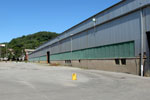
The old Ryerson Steel Building on Arch Street in Carnegie is the new home of the Envirosafe Stripping Corp., owned by George M. Vorel, who purchased it for $3 million. Anticipating expansion and growth with the addition of other tenants, he said, "You can't beat being where we are. It's next to the interstate and Carnegie is a great town." Jeffrey Widmer
The old Ryerson Steel Building on Arch Street in Carnegie, vacant for almost three years, has gotten a new owner, who has moved his company into it.
Envirosafe Stripping Inc., which specializes in industrial painting and multimedia blasting of steel bridge beams, moved into the building this month. The company, which has 19 employees, occupies 60,000-square-feet of the 250,000-square-foot building, which Envirosafe owner George M. Vorel purchased for $3 million.
The company joins one other tenant, which occupies 40,000 square feet, Vorel said.
“I think it’s just a matter of time before we have this building full. This is a very attractive building and Carnegie is a great place to come to. We may have it 75 or 80 percent full six months from now or it may be full, I’m not sure,” said Vorel of Beaver County.
Envirosafe was established in 1994 on the North Side and moved to Neville Island in 2000. The company had an opportunity to move to Ambridge, but Vorel said the Ryerson building was “too good to pass up.”
Vorel said he would have had to lease the Ambridge property. “We were not looking to lease property,” he said. He said he liked Carnegie’s location.
“You can’t beat being where we are. It’s next to the interstate and Carnegie is a great town,” he said.
The building itself, with its size and quality, is very appealing, Vorel said.
Carnegie Mayor Jack Kobistek said it took almost 2 1/2 months to work out the deal.
“But we are very happy, because the possibility of more businesses moving in means more jobs,” Kobistek said.
-
Part of Beloved Dormont Cinema to be Preserved
By Al Lowe
FOR THE TRIBUNE-REVIEW
Thursday, September 9, 2010History buffs got some good news at the Dormont Council meeting. Although Dormont’s South Hills Theater along West Liberty Avenue has been razed and will be replaced by a CVS store, its memories will live on because of plans to reassemble the theater’s box office and put it in the lobby of the municipal building.
“All I know is that I got a phone call one day at 3:30 p.m. and was told if I wanted the ticket booth, I better have it picked up by 4 p.m.,” said Muriel Moreland, who is president of the Dormont Historical Society. Her late husband, William, was the borough’s mayor for 24 years, until 1989.
Sections of the box office are being kept in her garage, off Espy Avenue.
“I hope they come get it soon because I have to put my lawn furniture there,” she said.
The Dormont municipal building has three rooms set aside for the Historical Society, which recently received a lot of memorabilia from the theater, including two masks denoting comedy and tragedy that once hung in the theater’s lobby. The theater opened in 1928 and closed in 2001, Moreland said.
Council member Joan Hodson said Monday, that, like many others, she and her husband, Jim, used to take their children to the theater. She said her husband will help to reassemble the box office in the lobby.
In other business, council voted 5-2 to pass a resolution in response to the Keystone Oaks School District’s proposal to close schools.
The resolution, written by Councilman John Maggio, states that council supports neighborhood schools and renews a willingness to collaborate with the district on planning efforts.
Heather Schmidt and Laurie Malkin cast the opposing votes.
They said they had no problems with the resolution, except for its timing. They thought that council should consider passing the resolution after a task force studying the district’s plans makes its recommendation.
Keystone Oaks is considering closing two kindergarten-through-fifth-grade elementary schools, Myrtle in Castle Shannon and Aiken in Green Tree, and converting Dormont Elementary from a K-5 school to a K-3 school for students from all three boroughs. The current middle school would be used for grades four through six, and the current high school would house grades seven through 12; grades seven eight would be kept apart from grades nine through 12.
-
Shuttered N. Point Breeze Firehouse Draws Interest
By Adam Brandolph
PITTSBURGH TRIBUNE-REVIEW
Thursday, September 9, 2010
Last updated: 10:22 am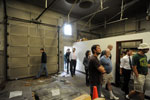
A former firehouse and Pittsburgh police training center at the corner of Penn and North Lang avenues was opened up this morning for potential buyers to get a look in Point Breeze. James Knox/Pittsburgh Tribune-Review
High ceilings, plenty of garage space, a classroom and a shooting range.
City officials believe Engine House No. 16 will make a great renovation.
“We want to see proposals, but we don’t have a preconceived notion of what we’re looking for,”said Claire Hosteny, senior real estate development specialist for the Urban Redevelopment Authority. “We’re just really excited because of the potential impact it could have on the neighborhood.”
Officials are seeking a buyer of the two-story brick building, located at North Lang and Penn avenues in North Point Breeze. About 30 people attended a tour of the property this morning.
The request for proposals can be found online at www.buyintheburgh.com. Bids are due Oct. 22.
The 6,500-square-foot building, which dates to the early 1900s, was last used as a firehouse in the late ’80s or early ’90s and has since been used as a police and fire training area. It is appraised at $90,000.
Eric Townsend of Forest Hills said the building’s nonexistent parking would be a problem if he decided to turn it into a nonprofit art studio.
“I’m just looking at everything and trying to get an idea of what’s available,” Townsend said.
Some architects and other potential investors touring the building said it would likely cost upward of $500,000 to renovate, but costs would fluctuate depending on what was done.
“I’ve never seen a turnout like this for a city property before,” said Michael Whartnaby of Point Breeze. “There’s definitely an interest.”
-
Healthy Downtown Business Program Shaping Up Eight Communities in Allegheny County
Wednesday, September 08, 2010?
Pop City Media
Allegheny Together, a small business revitalization organization, launched the Healthy Downtown Business Program last Wednesday to encourage employees and residents of eight communities to explore their commercial districts by foot.
The program has distributed walking maps to small businesses in Bellevue, Bridgevale, Coraopolis, Elizabeth, Stowe Township, Swissvale, Tarentum, and Verona, which encourage people to get physically fit while supporting downtown revitalization. In addition, they have also distributed walking logs, which allow participants to chart how much they walk through their downtown area.
“We have over 600 people signed up, which exceeds what we anticipated,” says Jessica Mooney, assistant manager of business development for Allegheny County Economic Development.
Business employees can look forward to special awards for their log efforts. At the end of September, the logs will be returned to Allegheny Together, and prizes will be given to the “healthiest downtown business” and “healthiest downtown business employee” in each community.
Allegheny Together was started in 2007 by Allegheny Economic Development in order to “reinvigorate small businesses by bringing residents back to our traditional, walkable shopping districts,” says Dan Onorato, county executive for Allegheny County.
Financial support for the Healthy Downtown Business Program comes form a combination of public and private funds made possible by the Health Department. Allegheny Together hopes to expand the program in the future, by offering more features, such as free pedometers and even more detailed walking maps.
Sign up to receive Pop City each week.
Source: Jessica Mooney, assistant manager of business development for Allegheny County Economic Development
Dan Onorato, county executive for Allegheny County
Writer: John FarleyPhotograph courtesy Mara Dowdy
-
The Pittsburgh Public Market Celebrates its Grand Opening this Friday
Wednesday, September 08, 2010
Pop City Media
If you haven’t been to the Pittsburgh Public Market in the Strip District, which opened softly on September 3rd, be sure to check it out this Friday, September 10th for the official grand opening. The 10,000 square foot space, which hosts over 40 vendors, is the first public market in Pittsburgh in 45 years.
The market features a diversity of small booth vendors, ranging from big name local operations wanting to fill a specific niche market to energetic startup operations hoping to make a name for themselves by virtue of the $25 per day rents. East End Brewery, for example, will be selling growlers to go. Be sure to pick up Indian seasonings or a meal-to-go from Spice by Tamarind, cure your sweet tooth at the Pittsburgh Candy Company, and grab some of the unique cured meats offered by the Crested Duck Charcuterie. There’s more to the market than food though, with booths like the crafty Babouche, and boutique skin care product vendor Tracy’s Treats.
The Pittsburgh Public Market is the brainchild of Neighbors in the Strip, which established a separate non-profit entity called the Strip District Market Counsel to run the operation. Plans for the market have been in development since 2003, and after extensive fundraising to the tune of $1.3 million and renovation work by architect Robert Indovina, the long awaited market is finally ready to become Pittsburgh’s next major tourist attraction, small business incubator, and community resource.
The market is located in the Produce Terminal Building near 17th and Smallman Streets. The grand opening ceremony will begin at 9 am this Friday. The first 100 visitors will receive a free tote bag, and a variety of entertainers and surprises will fill the building throughout the weekend. We can’t wait!
Sign up to receive Pop City each week.
Source: Becky Rodgers, Executive Director of Neighbors in the Strip
Writer: John FarleyPhotograph copyright John Farley

